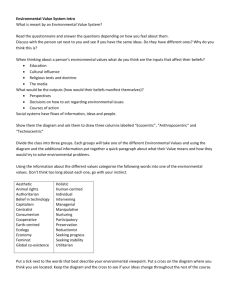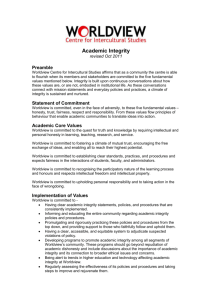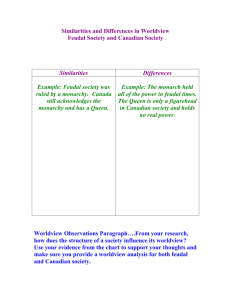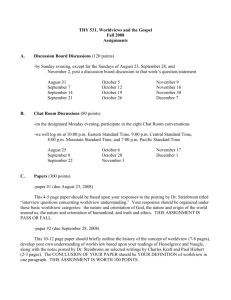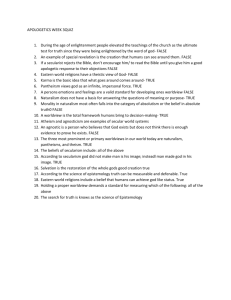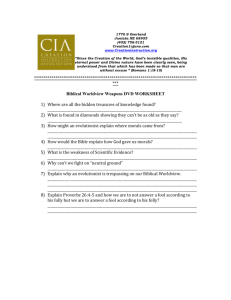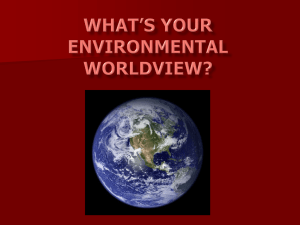Topic 7: Environmental Value Systems
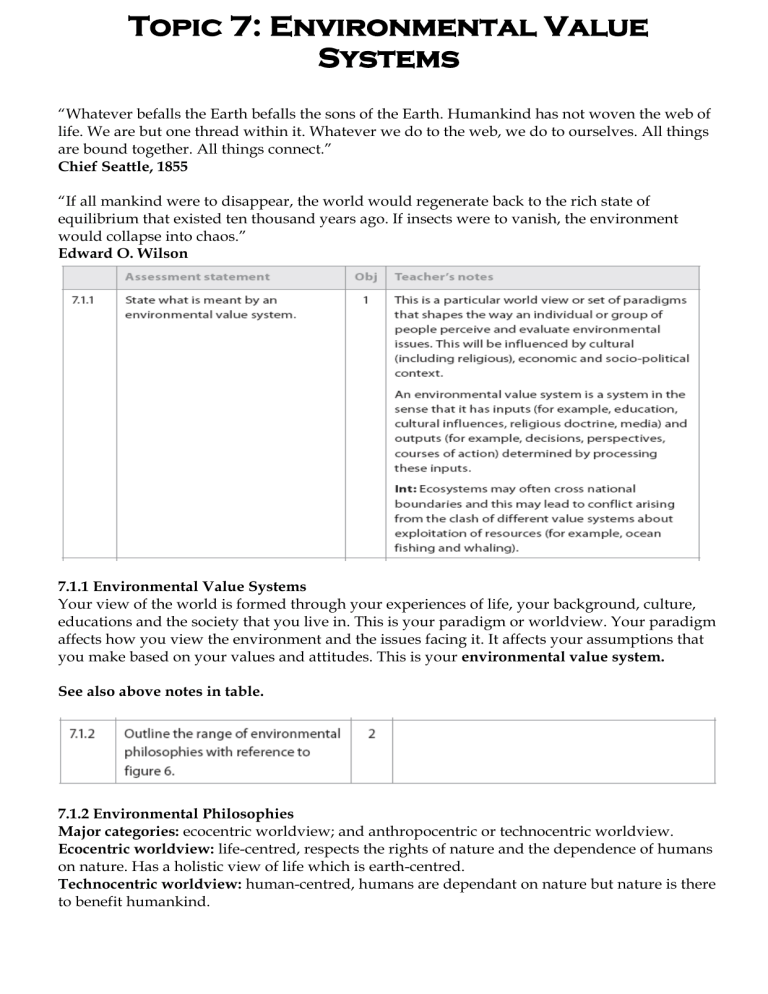
Topic 7: Environmental Value
Systems
“Whatever befalls the Earth befalls the sons of the Earth. Humankind has not woven the web of life. We are but one thread within it. Whatever we do to the web, we do to ourselves. All things are bound together. All things connect.”
Chief Seattle, 1855
“If all mankind were to disappear, the world would regenerate back to the rich state of equilibrium that existed ten thousand years ago. If insects were to vanish, the environment would collapse into chaos.”
Edward O. Wilson
7.1.1 Environmental Value Systems
Your view of the world is formed through your experiences of life, your background, culture, educations and the society that you live in. This is your paradigm or worldview. Your paradigm affects how you view the environment and the issues facing it. It affects your assumptions that you make based on your values and attitudes. This is your environmental value system.
See also above notes in table.
7.1.2 Environmental Philosophies
Major categories: ecocentric worldview; and anthropocentric or technocentric worldview.
Ecocentric worldview: life-centred, respects the rights of nature and the dependence of humans on nature. Has a holistic view of life which is earth-centred.
Technocentric worldview: human-centred, humans are dependant on nature but nature is there to benefit humankind.
Most people living in the more economically developed countries in the inductrial world have a
technocentric (planetary management) or anthropocentric (human-centred) worldview. Within this view humans are viewed as the dominant species on Earth and we can manage the environment to suit our own needs. Other species can only therefore have value if they are useful to us.
Technocentric/Anthropocentric people have the follow views:
We are the most important species
There will always be more resources to exploit
We will control and manage these resources and be successful
We can solve any pollution problem that we cause
Economic growth is a good thing and we can always keep the economy growing
In summary whatever we do we can solve it
Technocentric worldviews include the cornucopians and the environmental managers.
Cornucopians: include these people who see the world as having infinite resources to benefit humanity. They think that through inventiveness and technology we can solve any environmental problem. And continually improve our standard of living. Through free-market economy (capitalism with minimal government control) we will best manage our markets and planet.
Environmental Managers: view the Earth as a garden that needs tending. This is also called the
stewardship worldview. We have an ethical duty to protect and nurture the Earth. They hold the view that there are problems and that we need government to legislate to protect the environment and the resources from overexploitation and make economies sustainable. If we look after the planet it will look after us.
Ecocentric worldview: believes that the above views of technocentrics are too simplistic. We do not even know all the species that are alive on the planet, at present, nor how they react and therefore it is very arrogant to think that we can manage everything. Biocentric (life-centred) thinkers see all life as having inherent value, a value for its own sake. Ecocentrics include the
self-reliant or soft technologists. They believe in the importance of small-scale, local community action and the actions of individuals making a difference. They view materialism as wrong and do not like centralised decision making. Deep ecologists place more importance on nature than humanity. They believe in the biorights or universal rights where all species and ecosystems have an inherent value and humans have no right to interfere with this.
Ecocentric people have the following views:
The Earth is here for all species
Resources are limited
We should manage growth so that only beneficial forms occur
We must work with the Earth not against it
We need the Earth more than it needs us
See also Figure 6 below
7.1.3Another way to look at these alternate environmental view or value systems is to consider them as nurturing (ecocentric) and intervening or manipulative
(technocentric/anthropocentric). Most of us will not fall under one extreme of the other but share aspects or be considered to possess degrees of both. As we can only view the environment based on our human perceptions and experiences our views will be biased by these. Most us will take an accommodating view of the environment (”light
green”), faith that our institutions will adapt to environmental demands and changes and in communities to work together to reduce resource use. A large minority are cornucopians (“bright green”) with faith in the appliance of science to solve environmental problems and very few are deep ecologists (“dark green”) who believe in green rights and the survival of the planet above that of the human species.
“A thing is right when it tends to preserve the integrity, stability and beauty of the biotic community. It is wrong when it tends otherwise.” Aldo Leopold
7.1.4
A review of the major landmarks in environmentalism
Years Events
Early 1800’s Industrial Revolution in Europe
Significance
Increased urbanisation, resource usage and pollution
Late 1800’s
1940’s
1949
Influential individuals such as
Thoreau and Muir write books on conservation
Green Revolution – intensive technological agriculture
Leopold writes A Sandy County
Almanac
First conservation groups form and nature reserves established. NGO’s start to form
Resource use (especially fossil fuels) and pollution increased.
Human population increases dramatically
Concept of stewardship is applied to nature
1992
1990’s
2002
2005
1975
1982
1984
1987
1988
1956 to 1968
1962
1960’s to 1970’s
1972
Minamata Bay Disaster
Rachel Carson publishes Silent
Spring
NGO’s gain greater following
Emphasizes the ability of food chains to accumulate toxins into higher trophic levels, including humans
General acceptance of dangers of chemical toxins affecting humans. The pesticide DDT is banned
Public awareness grows,
WWF, Greenpeace, Friends of the Earth all formed
First Earth Summit – UN
Conference on the Human
Environment
CITES formed IUCN
Declaration of UN Conference.
Action Plan for Human
Environment. Environment
Fund established. Formation of UN Environmental
Programme (UNEP). Earth
Summit planned for 10-year intervals
Endangered species protected from international trade
Nairobi Earth Summit
Bhopal Disaster
Montreal Protocol
IPCC formed by UNEP
Ineffective
World’s worst industrial disaster
Nations agree to reduce CFC use
Advises governments of risk of climate change
Rio Earth Summit and Kyoto
Protocol
Green awareness strengthens
Johannesburg Earth Summit
Kyoto Protocol becomes a legal requirement
Agreement to reduce carbon emissions to counter enhanced greenhouse effect
Environmentally friendly products, recycling and ecotourism become popular
Plans to globally improve: water and sanitation, energy supply issues, health, agricultural abuse, and biodiversity reduction
174 countries signed and are expected to reduce carbon emissions to some 15% below expected 2008 emissions.
Expires 2012
2006
2008
2009
EU Climate Summit, Brussels
UN Climate Change Conference,
Poland
Film An Inconvenient Truth
Hopenhagen, UN Climate Change
Conference
Documentary by Al Gore
(former US vice president) on global warming
Reaffirmed 20-20-20 commitment (cut emissions by
20%, make 20% energy savings and generate 20% of energy from renewable resources by 2020
Reaffirm need to reduce carbon emissions. 192 nations represented
7.1.5
Communist and Capitalist Germany
Communism was seen as the antidote for capitalism (capitalistic greed) and communists believed that their system would produce more wealth and distribute it more equally, and cure social problems including environmental degradation. However journalist reported that East Germany was polluted with Buna chemical works dumping ten more mercury into its neighbouring river than a comparable
West German plant did in a year. And East German smoky twostroke Trabant cars emitted one hundred times as much carbon monoxide as a western car with a catalytic converter. The message was that capitalism was cleaning-up the industry however they were not such non-polluters themselves. In some ways the paternalistic communist state had protected the interests of primary producers like farmers and fishermen and so the environment. There was a law that made smelters shut down and so not pollute in spring when crops were growing.
"Capitalism and communism stand at opposite poles. Their essential difference is this: The communist, seeing the rich man and his fine home, says: 'No man should have so much.' The capitalist, seeing the same thing, says: 'All men should have as much.' "
–Phelps Adams
Native American Environmental Worldview
There are many views but the generalisation of their views is that they hold property in common (communal), have a subsistence economy, and barter for goods instead of using money, and use low impact technologies. Politically they come to consensus agreements by democratic processes. The laws are handed down by oral tradition.
Most communities have a matrilineal line (descent follows the female side) as opposed to patriarchal (fathers side), with extended families and low population density. In terms of religion, they are polytheistic
(worshipping many gods) and hold that animals and plants as well as natural objects have spiritual value.
Modern Western Worldview
The two religions with the most adherents are Christianity and Islam. They share the belief in separation of spirit and master or body and soul and a notion of ‘dominion’ or mastery over the
Earth. But the ancient Greek view of citizenship and democracy, the Judaic notion of the covenant and the Christian view of unconditional love are examples which have perhaps been distorted in the anthropocentric views of the West. In the biblical book of Genesis, God commands humans to “replenish the earth, and subdue it; and have dominion over it”. But what does this mean? Are humans to be masters or stewards of the Earth? Do stewards own something or just look after it? Another view is that of ecofeminism as an environmental movement, in which ecofeminists argue that it is the rise of male-dominated societies since the arrival of agriculture that has led to our view of nature as a foe to be conquered rather than nurtured by Earth mother.
Buddhism’s Environmental Worldview – a religious ecology
Buddhism has evolved to view the world as four conjoined aspects: morally; existentially; cosmologically; and ontologically. Buddhists believe that all beings share the conditions of birth, old age, suffering, and death, and that every living thing is co-dependent. Buddhist belief teaches that as we are all dependant on each other, whether plant or animal, we are not autonomous and humans can not be more important than other living things, and must extend loving-kindness and compassion not just to life but to the earth itself.
